Male Gear Wear (Gear Wear) is a men’s aerobic sports retailer in Ashland, Oregon. Gear Wear offers a comprehensive selection in town and on the Internet/mail order as well.
By offering a complete selection and knowledgeable support staff, Gear Wear will quickly gain market share.
Ashland was chosen for its diverse, active culture. People in Ashland often make job sacrifices for quality of life gains, and the majority of them lead an active, outdoor lifestyle. Gear Wear is an Oregon based L.L.C. primarily owned by Stan Gearboy.
Keys to Success:
1. Meet the customer’s needs with a comprehensive selection and knowledgeable staff.
2. Monitor the competitive environment to ensure differentiation.
3. Design and adhere to strict financial controls.
Competitive Edge:
Gear Wear’s edge is its unsurpassed selection and sales staff knowledge. No other store offers the comprehensiveness within multi-sports like Gear Wear. Athletes who participate in multiple aerobic sports do so as part of their lifestyle. While the activities may be somewhat painful during intense moments, overall they are enjoyable. This explains why they participate in many different sports.
Management:
Gear Wear is led by Stan Gearboy, a veteran of the outdoor sport industry. Stan was an active member of two different sport teams during undergraduate school, which sparked his passion for aerobically challenging sports. He gained experience at R.E.I., a successful outdoor retailer, before pursuing his dream of opening his own store. Through passion, experience, and education, Stan is the right person to lead Gear Wear to success.
Gear Wear forecasts explosive sales by the end of year two, escalating continually in year three. The net profit margin will be low in year two and increase modestly in year three. Gear Wear has sufficient cash to weather the first few years and build a sound foundation for the business, including a loyal customer base.
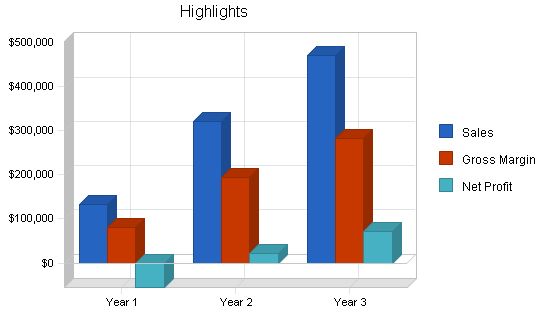
Contents
Objectives
- Become the premier men’s aerobic sports clothing retailer in Ashland.
- Increase market penetration to 10% by year three.
- Reach profitability within the second year.
Mission
Gear Wear’s mission is to become the premier men’s sports clothing retailer in Ashland. This will be accomplished by offering fair prices, the best selection, and a knowledgeable staff to assist customers. Gear Wear will strive to exceed customer expectations.
Keys to Success
- Meet customer needs by offering a comprehensive selection and knowledgeable staff.
- Monitor the competitive environment ensuring differentiation.
- Employ strict financial controls.
Company Summary
Gear Wear is an Ashland, Oregon based retailer of men’s aerobic sports clothing. Gear Wear will concentrate on running, cycling, cross country skiing and snowshoeing apparel.
Currently, local retailers offer these types of garments, however, most are sport specific, such as a bicycle shop or a running store. The few retailers that have a wide range of sports have limited inventories. This company was founded on the premise that most aerobic sport athletes participate in more than one activity.
Start-up Summary
Gear Wear is starting up the company. Legal counsel was consulted for various issues including business organization formation and contract negotiations. A business consultant was also utilized to gain insight into non-intuitive business issues. Gear Wear will incur $10,000 of build out expenses for the space. The following equipment will be needed for start-up:
- Cash register and bar code scanner.
- Computer system with printer, scanner, and Internet connection.
- Assorted display racks, shelves, mirrors, etc.
- Stereo system.
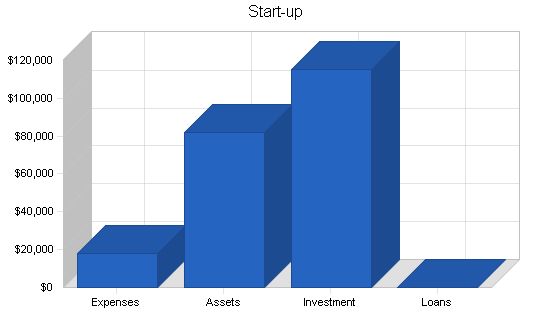
Start-up Funding
Start-up Expenses to Fund: $17,900
Start-up Assets to Fund: $82,100
Total Funding Required: $100,000
Assets
Non-cash Assets from Start-up: $9,000
Cash Requirements from Start-up: $73,100
Additional Cash Raised: $15,000
Cash Balance on Starting Date: $88,100
Total Assets: $97,100
Liabilities and Capital
Liabilities
Current Borrowing: $0
Long-term Liabilities: $0
Accounts Payable (Outstanding Bills): $0
Other Current Liabilities (interest-free): $0
Total Liabilities: $0
Capital
Planned Investment
Investor 1: $45,000
Investor 2: $25,000
Investor 3: $45,000
Additional Investment Requirement: $0
Total Planned Investment: $115,000
Loss at Start-up (Start-up Expenses): ($17,900)
Total Capital: $97,100
Total Capital and Liabilities: $97,100
Total Funding: $115,000
Start-up
Requirements
Start-up Expenses
Legal: $3,000
Stationery etc.: $300
Brochures: $200
Consultants: $2,500
Rent: $900
Research and Development: $1,000
Other: $10,000
Total Start-up Expenses: $17,900
Start-up Assets
Cash Required: $73,100
Start-up Inventory: $0
Other Current Assets: $0
Long-term Assets: $9,000
Total Assets: $82,100
Total Requirements: $100,000
2.2 Company Ownership
Gear Wear is an Oregon L.L.C. founded by Stan Gearboy in late 2002.
Products
Gear Wear sells a wide variety of male-only clothing for aerobic sports such as cycling, running, cross country skiing, and snowshoeing.
The main common element of the products for sale is NO cotton. Cotton is the worst possible fabric to make sportswear out of. Cotton absorbs and holds water, causing clothing to lose its insulating characteristics and becomes heavier. Additionally, when a garment is wet, friction is significantly increased, which can lead to blisters. Gear Wear’s mantra is “friends do not let friends wear cotton.” The following is a list of the products for sale:
– Shorts
– Long and short sleeve shirts
– Tights
– Water repellent shells
– Assorted fleece wear (jackets, pants, vests, hats, gloves)
– Socks
– Briefs, including wind briefs (with a wind resistant front panel)
Market Analysis Summary
Gear Wear has segmented its market into two distinct segments. The first segment is hardcore athletes, who are people dedicated to aerobic activities and already have most of the clothing they need. The second segment is newbies, who are new to aerobic activities and have a higher potential customer base. Each group will be targeted with a different strategy. The industry can be broken down into sport-specific retailers and all-encompassing sports/outdoor retailers. Gear Wear will offer a comprehensive selection of sportswear for aerobic activities.
4.1 Market Segmentation
Gear Wear’s market can be broken down into two distinct segments: hardcore athletes and newbies. Each group has distinctive demographics:
Hardcore Athletes
– Typically spend seven – 15 hours per week on training/activities
– Regularly participate in two to three different aerobic sport activities
– 61% have at least an undergraduate degree
– Have on average at least a $45,000 household income
Newbies
– Typically spend five – 10 hours a week training
– Recently started getting serious about aerobic activities
– 54% have undergraduate schooling or a degree
– Household income of over $47,000
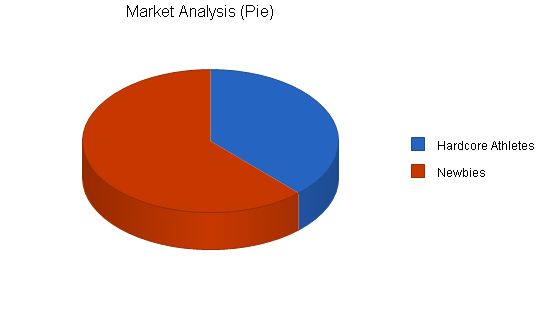
Market Analysis
Year 1 Year 2 Year 3 Year 4 Year 5
Potential Customers Growth CAGR
Hardcore Athletes 8% 8,097 8,745 9,445 10,201 11,017 8.00%
Newbies 9% 13,223 14,413 15,710 17,124 18,665 9.00%
Total 8.62% 21,320 23,158 25,155 27,325 29,682 8.62%
4.2 Target Market Segment Strategy
The market segmentation strategy is based on distinct buying patterns of different groups. Hardcore athletes have sport specific clothing and buy replacement pieces. These athletes appreciate subtle improvements and may purchase new products with improved designs. Newbies, who are new to aerobic activities, make less frequent but larger purchases. They provide an opportunity for Gear Wear to have a significant impact on their outfitting.
Gear Wear operates in the men’s retail clothing industry, specifically in the outdoor aerobic sports clothes niche. The aerobic sports clothing market is a $765 million industry. Located in Ashland, Oregon, Gear Wear benefits from a sports-minded town with access to various activities within a 20-minute drive. Products in this industry are purchased through local retailers or mail order companies that offer a wide assortment of different sports/human-powered activities.
4.3.1 Competition and Buying Patterns
Gear Wear faces competition from several sources:
– Run Pro: A running-only store with a variety of running-specific clothing.
– Two Wheel Drive: A bicycle shop with the best selection of cycling-specific clothing.
– Assorted ski retailers: Two ski retailers that sell primarily outerwear and base layers for cross country skiing.
– R.E.I.: A retailer and mail-order company with regional/local stores that offer a wide variety of men’s and women’s clothing. Limited choices within sport-specific clothing.
– Performance Bike Shop: A mail-order, cycling-specific retailer. Great selection, but unable to try on products.
– California Running: A leading running-specific mail-order house. Similar to Performance Bike Shop.
Hardcore athletes typically visit sport-specific stores or use mail order to make purchases. They appreciate technical aspects and broader selection. Newbies are more likely to make purchases from general retailers due to the wider variety of products offered.
Strategy and Implementation Summary
Gear Wear will achieve profitability by highlighting its competitive edge of an incredible selection. They offer one-stop shopping with true diversity. Gear Wear’s marketing strategy will be tailored to each market segment.
For hardcore athletes, Gear Wear will market as the most complete source of products. For newbies, Gear Wear will position itself as the knowledgeable source for various sports. Newbies are in search of information and value assistance from salespeople.
5.1 Competitive Edge
Gear Wear differentiates itself through an unsurpassed selection. It offers a complete range of sports apparel under one roof, providing convenience to customers. As the target customers participate in multiple sports, the value of finding everything in one store is substantial. While a large selection is not inherently sustainable, there are currently no indicators suggesting competitors entering this space. Retailers seem content with not specializing too much in any single or grouped activities.
5.2 Marketing Strategy
Gear Wear’s marketing strategy takes into account the two different market segments. They will be marketed as the complete resource for male sports clothing for hardcore users. Magazine/journal advertisements and sponsorships at competitions will increase visibility. For newbies, Gear Wear will stress the selection and offer knowledge and advice from salespeople. Advertisements in local outdoor sports journals will target this audience.
5.3 Sales Strategy
Gear Wear’s sales strategy aims to supplement its selection with well-informed salespeople who can explain product features and differentiations. Simply displaying clothing will not be enough; sales staff will educate customers on the benefits of specialized clothing. Proper training on technical details, fabric, fitting, and product knowledge will ensure a higher conversion rate from casual shoppers to qualified customers.
5.3.1 Sales Forecast
The first three months are expected to have minimal sales activity as the business sets up and gains familiarity. Sales will gradually increase in the first year, with profitability estimated by month 26. Sales revenue will continue to escalate throughout year three.
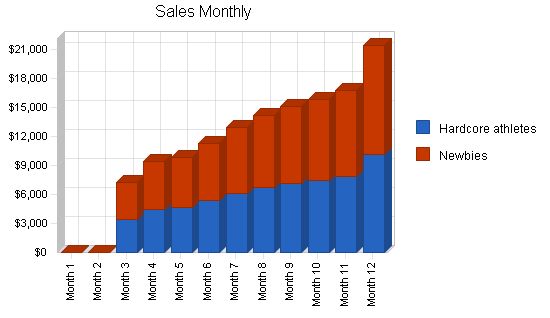
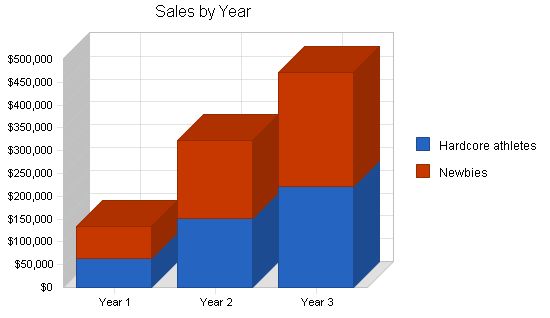
Sales Forecast:
| Sales Forecast | |||
| Year 1 | Year 2 | Year 3 | |
| Sales | |||
| Hardcore athletes | $63,157 | $151,889 | $222,090 |
| Newbies | $70,736 | $170,116 | $248,741 |
| Total Sales | $133,893 | $322,005 | $470,831 |
| Direct Cost of Sales | Year 1 | Year 2 | Year 3 |
| Hardcore athletes | $25,263 | $60,756 | $88,836 |
| Newbies | $28,294 | $68,046 | $99,496 |
| Subtotal Direct Cost of Sales | $53,557 | $128,802 | $188,332 |
5.4 Milestones
- Completion of business plan
- Securing retail space
- First month the doors are open
- Profitability
- Explosive sales revenue

| Milestones |
Management Summary
Stan Gearboy received his undergraduate degree from the University of Oregon. While at the University, Stan was on both the cycling and cross country ski teams. It was in college where Stan realized his passion for pushing his body and mind aerobically.
After school, Stan worked at R.E.I., initially on the sales floor for two years, then moving to a managerial position. Stan worked at R.E.I. for five years, gaining a comprehensive understanding of the retail outdoor market. Despite his dream of owning his own business, Stan felt he needed to further develop his skill set and decided to pursue a Masters in Business.
Stan chose Southern Oregon University in Ashland due to its active culture and proximity to the mountains. While at school, Stan recognized the opportunity to open a retail establishment focused on men’s aerobic sports clothing. He formulated parts of the business plan during his second year of school and, after graduation, secured a significant loan through the school’s entrepreneurship program to start Gear Wear.
6.1 Personnel Plan
Stan will initially handle multiple roles within the organization, including sales, marketing, procurement, and business development. Gear Wear will have a maximum of three salespeople on the floor, who will also serve as customer service agents if needed. Two support staff agents will assist with unpacking, inventory introduction, and merchandising. The bookkeeping duties will be performed by a part-time employee, with financial reviews conducted by a local CPA firm every two to four weeks.
| Personnel Plan | |||
| Year 1 | Year 2 | Year 3 | |
| Stan | $24,000 | $30,000 | $33,000 |
| Sales staff | $27,000 | $35,000 | $40,000 |
| Support staff | $22,500 | $27,000 | $29,000 |
| Bookkeeper | $19,700 | $24,000 | $28,000 |
| Total People | 6 | 8 | 9 |
| Total Payroll | $93,200 | $116,000 | $130,000 |
Financial Plan
The following sections outline the key financial strategy for Gear Wear.
7.1 Important Assumptions
The table below details the important financial assumptions.
| General Assumptions | |||
| Year 1 | Year 2 | Year 3 | |
| Plan Month | 1 | 2 | 3 |
| Current Interest Rate | 10.00% | 10.00% | 10.00% |
| Long-term Interest Rate | 10.00% | 10.00% | 10.00% |
| Tax Rate | 30.00% | 30.00% | 30.00% |
| Other | 0 | 0 | 0 |
7.2 Break-even Analysis
The break-even analysis indicates the monthly revenue needed to reach the break-even point.
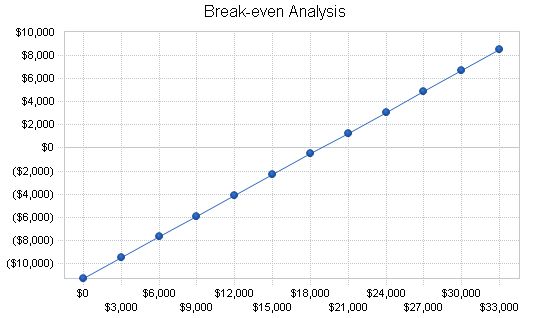
Break-even Analysis:
Monthly Revenue Break-even: $18,844
Assumptions:
Average Percent Variable Cost: 40%
Estimated Monthly Fixed Cost: $11,307
Projected Profit and Loss:
The table and charts below display the projected profit and loss.
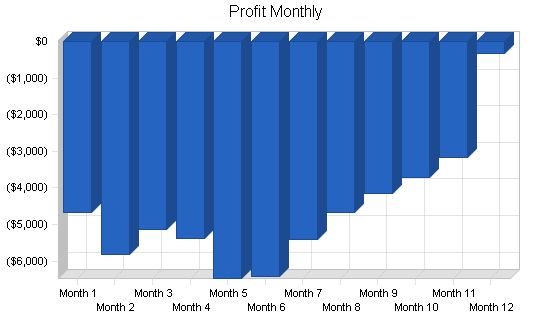
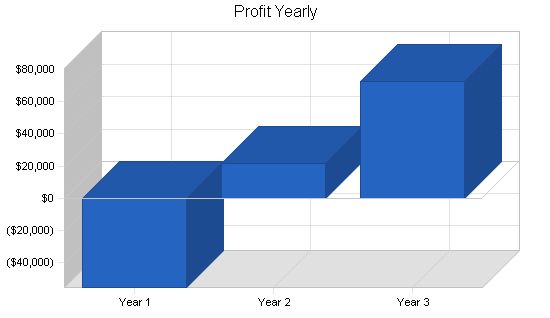
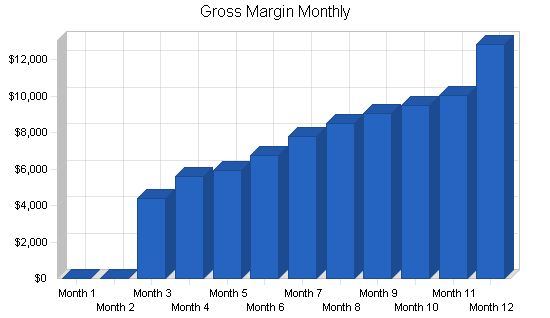
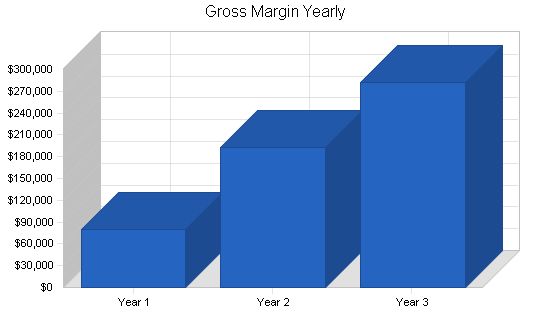
Pro Forma Profit and Loss
Year 1 Year 2 Year 3
Sales $133,893 $322,005 $470,831
Direct Cost of Sales $53,557 $128,802 $188,332
Other Costs of Goods $0 $0 $0
Total Cost of Sales $53,557 $128,802 $188,332
Gross Margin $80,336 $193,203 $282,498
Gross Margin % 60.00% 60.00% 60.00%
Expenses – – –
Payroll $93,200 $116,000 $130,000
Sales and Marketing and Other Expenses $6,000 $6,000 $6,000
Depreciation $1,800 $1,800 $1,800
Rent $10,800 $11,000 $11,000
Utilities $3,600 $3,600 $3,600
Insurance $3,900 $4,500 $4,500
Payroll Taxes $13,980 $17,400 $19,500
Other $2,400 $2,400 $2,400
Total Operating Expenses $135,680 $162,700 $178,800
Profit Before Interest and Taxes ($55,344) $30,503 $103,698
EBITDA ($53,544) $32,303 $105,498
Interest Expense $0 $0 $0
Taxes Incurred $0 $9,151 $31,110
Net Profit ($55,344) $21,352 $72,589
Net Profit/Sales -41.33% 6.63% 15.42%
7.4 Projected Cash Flow
The following table and chart presents the Projected Cash Flow.
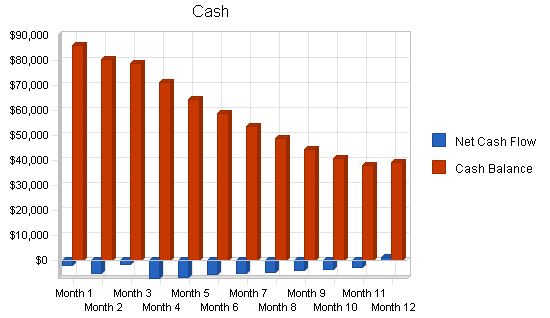
Pro Forma Cash Flow
| Pro Forma Cash Flow | |||
| Year 1 | Year 2 | Year 3 | |
| Cash Sales | $133,893 | $322,005 | $470,831 |
| Subtotal Cash from Operations | $133,893 | $322,005 | $470,831 |
| Sales Tax, VAT, HST/GST Received | $0 | $0 | $0 |
| New Current Borrowing | $0 | $0 | $0 |
| New Other Liabilities (interest-free) | $0 | $0 | $0 |
| New Long-term Liabilities | $0 | $0 | $0 |
| Sales of Other Current Assets | $0 | $0 | $0 |
| Sales of Long-term Assets | $0 | $0 | $0 |
| New Investment Received | $0 | $0 | $0 |
| Subtotal Cash Received | $133,893 | $322,005 | $470,831 |
| Expenditures from Operations | Year 1 | Year 2 | Year 3 |
| Cash Spending | $93,200 | $116,000 | $130,000 |
| Bill Payments | $89,861 | $193,772 | $270,272 |
| Subtotal Spent on Operations | $183,061 | $309,772 | $400,272 |
| Subtotal Cash Spent | $183,061 | $309,772 | $400,272 |
| Net Cash Flow | ($49,168) | $12,233 | $70,559 |
| Cash Balance | $38,932 | $51,165 | $121,724 |
7.5 Projected Balance Sheet
The following table shows the Projected Balance Sheet.
| Pro Forma Balance Sheet | |||
| Year 1 | Year 2 | Year 3 | |
| Cash | $38,932 | $51,165 | $121,724 |
| Inventory | $9,422 | $22,660 | $33,133 |
| Other Current Assets | $0 | $0 | $0 |
| Total Current Assets | $48,354 | $73,825 | $154,857 |
| Long-term Assets | $7,200 | $5,400 | $3,600 |
| Total Assets | $55,554 | $79,225 | $158,457 |
| Current Liabilities | $13,798 | $16,117 | $22,760 |
| Long-term Liabilities | $0 | $0 | $0 |
| Total Liabilities | $13,798 | $16,117 | $22,760 |
| Paid-in Capital | $115,000 | $115,000 | $115,000 |
| Retained Earnings | ($17,900) | ($73,244) | ($51,892) |
| Earnings | ($55,344) | $21,352 | $72,589 |
| Total Capital | $41,756 | $63,108 | $135,697 |
| Total Liabilities and Capital | $55,554 | $79,225 | $158,457 |
| Net Worth | $41,756 | $63,108 | $135,697 |
7.6 Business Ratios
The following table indicates key Business Ratios for this company compared to industry averages for Clothing Stores.
| Ratio Analysis | ||||
| Year 1 | Year 2 | Year 3 | Industry Profile | |
| Sales Growth | 0.00% | 140.49% | 46.22% | 5.27% |
| Inventory | 16.96% | 28.60% | 20.91% | 38.34% |
| Other Current Assets | 0.00% | 0.00% | 0.00% | 26.48% |
| Total Current Assets | 87.04% | 93.18% | 97.73% | 88.71% |
| Long-term Assets | 12.96% | 6.82% | 2.27% | 11.29% |
| Total Assets | 100.00% | 100.00% | 100.00% | 100.00% |
| Current Liabilities | 24.84% | 20.34% | 14.36% | 37.92% |
| Long-term Liabilities | 0.00% | 0.00% | 0.00% | 12.86% |
| Total Liabilities | 24.84% | 20.34% | 14.36% | 50.78% |
| Net Worth | 75.16% | 79.66% | 85.64% | 49.22% |
| Sales | 100.00% | 100.00% | 100.00% | 100.00% |
| Gross Margin | 60.00% | 60.00% | 60.00% | 14.97% |
| Selling, General & Administrative Expenses | 101.33% | 49.59% | 41.34% | 6.56% |
| Advertising Expenses | 0.00% | 0.00% | 0.00% | 1.14% |
| Profit Before Interest and Taxes | -41.33% | 9.47% | 22.02% | 1.32% |
| Current | 3.50 | 4.58 | 6.80 | 2.10 |
| Quick | 2.82 | 3.17 | 5.35 | 0.86 |
| Total Debt to Total Assets | 24.84% | 20.34% | 14.36% | 57.27% |
| Pre-tax Return on Net Worth | -132.54% | 48.33% | 76.42% | 4.00% |
| Pre-tax Return on Assets | -99.62% | 38.50% | 65.44% | 9.36% |
| Net Profit Margin | -41.33% | 6.63% | 15.42% | n.a |
| Return on Equity | -132.54% | 33.83% | 53.49% | n.a |
| Inventory Turnover | 10.91 | 8.03 | 6.75 | n.a |
| Accounts Payable Turnover | 7.51 | 12.17 | 12.17 | n.a |
| Payment Days | 27 | 28 | 26 | n.a |
| Total Asset Turnover | 2.41 | 4.06 | 2.97 | n.a |
| Debt to Net Worth | 0.33 | 0.26 | 0.17 | n.a |
| Current Liab. to Liab. | 1.00 | 1.00 | 1.00 | n.a |
| Net Working Capital | $34,556 | $57,708 | $132,097 | n
General Assumptions: Month 1, Month 2, Month 3, Month 4, Month 5, Month 6, Month 7, Month 8, Month 9, Month 10, Month 11, Month 12. Plan Month: 1, 2, 3, 4, 5, 6, 7, 8, 9, 10, 11, 12. Current Interest Rate: 10.00% Long-term Interest Rate: 10.00% Tax Rate: 30.00% Other: 0 Pro Forma Profit and Loss: Month 1, Month 2, Month 3, Month 4, Month 5, Month 6, Month 7, Month 8, Month 9, Month 10, Month 11, Month 12. Sales: $0, $0, $7,278, $9,353, $9,847, $11,285, $12,957, $14,176, $15,077, $15,802, $16,701, $21,414 Direct Cost of Sales: $0, $0, $2,911, $3,741, $3,939, $4,514, $5,183, $5,671, $6,031, $6,321, $6,681, $8,566 Other Costs of Goods: $0, $0, $0, $0, $0, $0, $0, $0, $0, $0, $0, $0 Total Cost of Sales: $0, $0, $2,911, $3,741, $3,939, $4,514, $5,183, $5,671, $6,031, $6,321, $6,681, $8,566 Gross Margin: $0, $0, $4,367, $5,612, $5,908, $6,771, $7,774, $8,506, $9,046, $9,481, $10,021, $12,848 Gross Margin %: 0.00%, 0.00%, 60.00%, 60.00%, 60.00%, 60.00%, 60.00%, 60.00%, 60.00%, 60.00%, 60.00%, 60.00% Expenses: Payroll: $2,000, $3,000, $6,200, $7,500, $8,700, $9,400, $9,400, $9,400, $9,400, $9,400, $9,400, $9,400 Sales and Marketing and Other Expenses: $500, $500, $500, $500, $500, $500, $500, $500, $500, $500, $500, $500 Depreciation: $150, $150, $150, $150, $150, $150, $150, $150, $150, $150, $150, $150 Rent: $900, $900, $900, $900, $900, $900, $900, $900, $900, $900, $900, $900 Utilities: $300, $300, $300, $300, $300, $300, $300, $300, $300, $300, $300, $300 Insurance: $325, $325, $325, $325, $325, $325, $325, $325, $325, $325, $325, $325 Payroll Taxes: 15%, $300, $450, $930, $1,125, $1,305, $1,410, $1,410, $1,410, $1,410, $1,410, $1,410 Other: $200, $200, $200, $200, $200, $200, $200, $200, $200, $200, $200, $200 Total Operating Expenses: $4,675, $5,825, $9,505, $11,000, $12,380, $13,185, $13,185, $13,185, $13,185, $13,185, $13,185, $13,185 Profit Before Interest and Taxes: ($4,675), ($5,825), ($5,138), ($5,388), ($6,472), ($6,414), ($5,411), ($4,679), ($4,139), ($3,704), ($3,164), ($337) EBITDA: ($4,525), ($5,675), ($4,988), ($5,238), ($6,322), ($6,264), ($5,261), ($4,529), ($3,989), ($3,554), ($3,014), ($187) Interest Expense: $0, $0, $0, $0, $0, $0, $0, $0, $0, $0, $0, $0 Taxes Incurred: $0, $0, $0, $0, $0, $0, $0, $0, $0, $0, $0, $0 Net Profit: ($4,675), ($5,825), ($5,138), ($5,388), ($6,472), ($6,414), ($5,411), ($4,679), ($4,139), ($3,704), ($3,164), ($337) Net Profit/Sales: 0.00%, 0.00%, -70.60%, -57.60%, -65.72%, -56.84%, -41.76%, -33.01%, -27.45%, -23.44%, -18.95%, -1.57% Pro Forma Cash Flow: Month 1, Month 2, Month 3, Month 4, Month 5, Month 6, Month 7, Month 8, Month 9, Month 10, Month 11, Month 12. Cash Received: Cash from Operations: $0, $0, $7,278, $9,353, $9,847, $11,285, $12,957, $14,176, $15,077, $15,802, $16,701, $21,414 Subtotal Cash from Operations: $0, $0, $7,278, $9,353, $9,847, $11,285, $12,957, $14,176, $15,077, $15,802, $16,701, $21,414 Additional Cash Received: Sales Tax, VAT, HST/GST Received: 0.00%, $0, $0, $0, $0, $0, $ Pro Forma Balance Sheet: |
| Pro Forma Balance Sheet | |||||||||||||
| Month 1 | Month 2 | Month 3 | Month 4 | Month 5 | Month 6 | Month 7 | Month 8 | Month 9 | Month 10 | Month 11 | Month 12 | ||
| Assets | Starting Balances | ||||||||||||
| Cash | $88,100 | $86,016 | $80,486 | $78,669 | $71,296 | $64,450 | $58,611 | $53,362 | $48,575 | $44,403 | $40,736 | $37,748 | $38,932 |
| Inventory | $0 | $0 | $0 | $3,202 | $4,116 | $4,333 | $4,965 | $5,701 | $6,238 | $6,634 | $6,953 | $7,349 | $9,422 |
| Other Current Assets | $0 | $0 | $0 | $0 | $0 | $0 | $0 | $0 | $0 | $0 | $0 | $0 | $0 |
| Total Current Assets | $88,100 | $86,016 | $80,486 | $81,871 | $75,412 | $68,782 | $63,577 | $59,063 | $54,812 | $51,037 | $47,689 | $45,096 | $48,354 |
| Long-term Assets | |||||||||||||
| Long-term Assets | $9,000 | $9,000 | $9,000 | $9,000 | $9,000 | $9,000 | $9,000 | $9,000 | $9,000 | $9,000 | $9,000 | $9,000 | $9,000 |
| Accumulated Depreciation | $0 | $150 | $300 | $450 | $600 | $750 | $900 | $1,050 | $1,200 | $1,350 | $1,500 | $1,650 | $1,800 |
| Total Long-term Assets | $9,000 | $8,850 | $8,700 | $8,550 | $8,400 | $8,250 | $8,100 | $7,950 | $7,800 | $7,650 | $7,500 | $7,350 | $7,200 |
| Total Assets | $97,100 | $94,866 | $89,186 | $90,421 | $83,812 | $77,032 | $71,677 | $67,013 | $62,612 | $58,687 | $55,189 | $52,446 | $55,554 |
| Liabilities and Capital | |||||||||||||
| Total Liabilities | $0 | $2,441 | $2,586 | $8,960 | $7,738 | $7,430 | $8,489 | $9,235 | $9,514 | $9,727 | $9,933 | $10,354 | $13,798 |
| Paid-in Capital | $115,000 | $115,000 | $115,000 | $115,000 | $115,000 | $115,000 | $115,000 | $115,000 | $115,000 | $115,000 | $115,000 | $115,000 | $115,000 |
| Retained Earnings | ($17,900) | ($17,900) | ($17,900) | ($17,900) | ($17,900) | ($17,900) | ($17,900) | ($17,900) | ($17,900) | ($17,900) | ($17,900) | ($17,900) | ($17,900) |
| Earnings | $0 | ($4,675) | ($10,500) | ($15,638) | ($21,026) | ($27,498) | ($33,912) | ($39,322) | ($44,002) | ($48,140) | ($51,844) | ($55,008) | ($55,344) |
| Total Capital | $97,100 | $92,425 | $86,600 | $81,462 | $76,074 | $69,602 | $63,188 | $57,778 | $53,098 | $48,960 | $45,256 | $42,092 | $41,756 |
| Total Liabilities and Capital | $97,100 | $94,866 | $89,186 | $90,421 | $83,812 | $77,032 | $71,677 | $67,013 | $62,612 | $58,687 | $55,189 | $52,446 | $55,554 |
| Net Worth | $97,100 | $92,425 | $86,600 | $81,462 | $76,074 | $69,602 | $63,188 | $57,778 | $53,098 | $48,960 | $45,256 | $42,092 | $41,756 |

Business Plan Outline
– Products
– Market Analysis Summary
– Strategy and Implementation Summary
– Management Summary
– Appendix
Hello!
I’m Andrew Brooks, a seasoned finance consultant from the USA and the mind behind phonenumber247.com.
My career is built on a foundation of helping individuals and businesses thrive financially in an ever-changing economic landscape. At phonenumber247.com, my aim is to demystify the complex world of finance, providing clear, actionable advice that can help you navigate your financial journey with confidence. Whether it’s personal finance management, investment strategies, or understanding the nuances of market dynamics, I’m here to share insights and tools that can propel you towards your financial goals.
Welcome to my digital space, where every piece of advice is a step closer to financial clarity and success!
